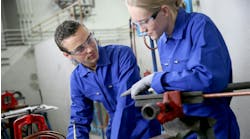Latest from Management
Sponsored
Recently, I watched a plumber program a new heating/domestic hot water system for a friend’s custom home. After marveling at the technology available to the trades these days, and the training needed to use it to its fullest advantage, I got to musing about how we got here... and where we came from.
The age of the computer is a relatively new event in human history. Much like the automobile, it changed the nation and the world in ways we are still discovering. Except that the digital age has performed these changes in record time and to a much deeper level for humanity than the industrial revolution did.
Theater of the Mind
The industrial revolution was great for reducing physical labor and making life in general easier for human beings. The digital revolution has affected the very thought processes of the human mind. Consider that this column is being written on a laptop computer, whose technology has been readily available for only 25 years or so. Moving electrons instead of typing on an old Smith Corona ® (which was also the result of technological advances brought about by the industrial revolution) is just one of many advances brought in by the computer age. In fact, computing power being what it is today, I could just as easily have spoken these words into my computer and produced this column. I suppose the next step would be for the computer to read my thoughts!
The presentation of graphic images has risen to such a state of excellence that computer generated images cannot be distinguished from reality. What is real? What is computer generated? I dare you to try and figure that out today. Virtual worlds have been invented, populated and destroyed in a blink. Technological advances come piled upon technological advances so quickly that we have come to expect new things almost as soon as we think of them.
Back to the Physical
All the foregoing begs the question; at what point do the digital and physical meet? Watching the young plumber programming that boiler/heater system made me think. The end product was a computer controlled, in home domestic hot water and comfort-controlled heating system, but that was only the end product. How did the system, as complex and digitally awesome as it was, get installed?
The answer is, of course, by tradesmen. There is not, at least at this particular time and place, anything that can take the place of craftsmen installing the systems which the computers can then control. That takes not only physical labor, but the skills and training required to properly put the pieces together in order that everything works as designed. Regardless of what a computer can do with the technology once it is in place and ready to function, it still takes a human being who has been properly trained, and is skilled within that trade, to actually put everything together so that it works as advertised.
A Stroll Down Memory Lane
Thinking back a mere 70 years ago (68 to be precise, but who’s counting? I was six at the time), I can remember my dad and grandfather working on a wooden water main, in a ditch, on a street in Brooklyn, New York. They were repairing a water line made of lead pipe! How’s that for old school? OSHA and the EPA would have had apoplexy! My grandpa had a full set of “mole skins” (the actual hides of moles) for wiping lead joints on lead pipe from 1/2” up to 4”. The mole skins had conformed precisely to his hands over time and when he needed one, he would just say something like, “give me that 3-inch skin, would ya?”
Then there was the joy (sarcasm fully intended) of “cutting” cast iron pipe. For those of you who don’t know what I’m talking about; the method of cutting cast iron pipe back in the day was to “score” it with a chisel along a circumference line around the pipe using a three-pound sledge hammer (hitting yourself on the hand on more than one occasion) until the pipe, literally, snapped. Sometimes, the cut didn’t go as planned and you’d end up with a jagged end or a crack rendering the piece useless. Invariably, this occurred about ten minutes before the end of the workday, causing the unlucky apprentice to be berated or worse!
Progress... and More Progress
All of this cast iron cutting fun came to a halt in 1957 when the Wheeler company was founded. The company was based upon the premise of making a better mousetrap. They invented a tool called a cast iron SNAPPER! This miracle tool allowed one to cut a length of cast iron without using a hammer and chisel... in seconds!! You could almost hear apprentices across the nation cheer!
Joining hub and spigot cast iron was still done the way it had been done for at least a century or more: lead and oakum. For those readers who are not familiar with that method of joining soil pipe, oakum (a bituminous fiber) came in 30” lengths. They were yarned into the bell end of a joint using a yarning iron until there was enough material to pack, using a packing iron. Once the joint was packed tight and rigid with the oakum, about two inches from the lip of the bell, molten lead was ladled from a pot set up on top of an LP gas bottle.
The entire melting station including the LP bottle and the burner assembly was called a “bomb” because that is what it resembled... an honest to goodness aerial bomb! Anyway, the molten lead was poured into the void around the joint and allowed to cool. Woe be unto the apprentice or plumber who allowed water to migrate anywhere near the joint where the lead was being poured! The lead would hit that moisture and explode! Sort of what happen with a deep fryer for turkey. Once cool, the lead was “tapped up” using a different set of irons (inside and outside), stiffening it to its final location.
Then came “No Hub” and TY Seal. Once more, apprentices across the country cheered!
Potable water piping, too, has evolved. Where lead, galvanized steel and red brass were once the preferred material for household water supply, copper tube, and then plastics like PVC/CPVC, poly-butylene and PEX, were invented and inserted into the marketplace. Threading domestic water pipe to join it was common practice until the 1960’s across much of the country. Many municipalities were skeptical of plastic water piping until IAPMO certified it. Thereafter, innovation after innovation came to market.
Perspective
Coming full circle, one can see that the digital revolution, while adding much to the available technology of the trades, is merely another tool to make our jobs easier. It does nothing to supplant trade skills and training. It can be clearly noted that no matter what new digital magic is invented and brought to market, the ability to do the work is unchanged. Until they invent a robot or machine that can install a plumbing or HVAC system from the ground up—and make it work—the skilled craftsman is an indispensable part of the equation. Now the imperative is to train the next generation and imbue them with the same sense of our trade that seems to have been lost, or at least, diluted.
The Brooklyn, N.Y.-born author is a retired third generation master plumber. He founded Sunflower Plumbing & Heating in Shirley, N.Y., in 1975 and A Professional Commercial Plumbing Inc. in Phoenix in 1980. He holds residential, commercial, industrial and solar plumbing licenses and is certified in welding, clean rooms, polypropylene gas fusion and medical gas piping. He can be reached at [email protected].
Al Schwartz | Founder
The Brooklyn, N.Y.-born author is a retired third generation master plumber. He founded Sunflower Plumbing & Heating in Shirley, N.Y., in 1975 and A Professional Commercial Plumbing Inc. in Phoenix in 1980. He holds residential, commercial, industrial and solar plumbing licenses and is certified in welding, clean rooms, polypropylene gas fusion and medical gas piping. He can be reached at [email protected].


